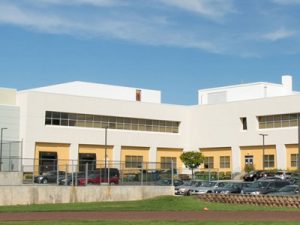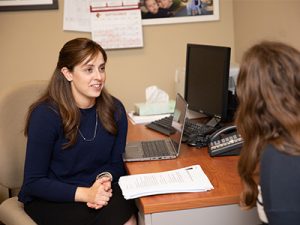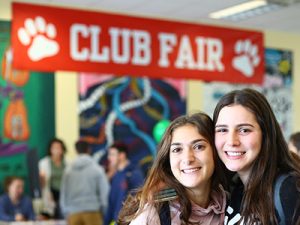Engineering
The two-year Engineering Track challenges students to expand their intellects and develop skills in inquiry, critical thinking, problem solving, research, and presentation. They develop the ability to access and analyze information and see the world through multiple perspectives. The Engineering Track combines the disciplines of science, technology, engineering, and mathematics (STEM).
9th Grade
Principles of Engineering: Foundations of Engineering and Electronics
Students are introduced to the foundations of engineering design as they investigate systems and their classification, function and purpose. They learn problem solving skills, dimension and unit analysis, measurements, calculations, documentation and teamwork. Students then explore the foundations of electronics in the lab including ohms law, voltage dividers, series and parallel circuits. They build and test circuits using electronic components and breadboards and experiment with meters and various sensors.
Foundations of Feedback and Control
Students discover the need for feedback and control in system design. They learn coding by programming the Arduino micro-controller to integrate control and sensors as they design and develop working systems. Students work with variables, loops, analog and digital data types and functions.
10th Grade
Applied Engineering: Bioelectronics
Students work with advanced electronic hardware and meters to build and test working prototypes. They experiment with the oscilloscope, RF transmitters, capacitors, transistors, Op amps, H-bridges, advanced motors, logic gates and biological sensors. Students apply and expand their coding skills to integrate hardware and software using the Arduino micro-controller for feedback and control.
Digital Design & Fabrication
Students get a hands-on introduction to the world of 3-D printing and learn about how 3-D printing has changed the way we design and manufacture. They use CAD software to design and print, as they design custom working parts and integrate them into their final projects.
11th Grade
Computer Science: Topics in Application Development
An in-depth study of Java as a programming language, students learn the basics of Java syntax and object-oriented programming, and cover topics such as the design of graphical user interfaces, working with network communication, and creating multi-threaded applications. The class introduces discrete mathematics, data structures and algorithms, and object-oriented programming design concepts: abstraction, inheritance, and polymorphism. Through this study of foundational topics and their hands-on applications, students develop full proficiency in reading and writing Java code. This course prepares students for the AP Computer Science A exam.
Computer Science Principles and Problems
An introduction to programming and developing applications for the internet using JavaScript and Python, this class also covers topics such as network structure, cybersecurity, TCP/IP protocols, and the web design markup language HTML with CSS. Students pursue independent projects while learning the basics of computer programming: variables, loops, conditionals, and functions. This course prepares students for the AP Computer Science Principles exam.
Basic Robotics
The project-based robotics course covers the fundamentals of robotics, microcontrollers, programming, sensors and actuators. Students use the LEGO Mindstorms NXT kits and RobotC programming language. Students not only build robots with sensor attachments, but also design algorithms to solve problems and write computer programs to implement them. Each project highlights a different challenge using diverse sensors. In addition to programming, the course covers mechanical and structural design, odometry, touch sensors, color and light sensors, ultrasonic sensors, gears and power, motors and other actuators, including some computer architecture.
Advanced Robotics
Building upon knowledge gained from the introductory robotics course, students are presented with specific problems that they have to design their own robots to solve. Students work on project challenges such as a robot that must find the exact center when placed in a bounded circle, a “rescue robot” that must travel through corridors in a simulated building and rescue inhabitants without touching any walls, a robot to pick up and place a small wooden block in a bowl, a gear computer that does arithmetic calculations and displays results, a golf playing robot, a robot that plays music through movement, etc. The class presents an exciting challenge for technically adept students who are looking to expand their knowledge of robotics and computer programming, as well as develop their creative problem solving skills.
Digital Design and Fabrication: Principles of Mechanical Engineering
Mechanical engineers apply engineering, physics, and materials science principles to design, analyze, manufacture, and maintain mechanical systems. Students learn skills in mechanical engineering, digital design, fabrication, product design and machine assembly. They apply the skills acquired in engineering I & II with design and fabrication in the makerspace. Students create working systems that incorporate components they design, using 3D and 2D technologies of Fusion360®, Adobe Illustrator®, and other CAD software platforms. They fabricate parts with laser cutters, a suite of 3D printers, milling machines, and other high tech equipment and tools. Students design with precision measuring skills and incorporate electronic components to control their designs. This course is project-based and assessed with project rubrics.
12th Grade
Physics for Scientists and Engineers (Honors)
Students interested in science and engineering learn how to apply differential and integral calculus to problem solving in mechanics and electricity and magnetism in this calculus-based general physics class. Concurrent enrollment in calculus is a requirement and supplemental weekly labs cover topics in electricity and magnetism as well as optics and modern physics. Students are expected to complete lab reports with mathematical analyses of their data done in graphical analysis software, as well as to investigate numerical methods and quantitative data analysis in great depth using scientific software.
Environmental Science–Modeling/Analyzing the Interrelationships of the Natural World (Honors)
Students explore the interrelationships of the natural world and are introduced to the scientific principles, concepts, and methodologies needed to understand both natural and human-made environmental problems and to examine possible solutions. Topics include earth systems, ecosystems, population dynamics, land and water use, energy resources and consumption, pollution, and global change.
Torah, Science and Engineering – Merging Halachic Judaism with Modern Life
Students learn Hilchot Shabbat including the laws of boneh, gerama and milechet machshevet and explore the halachic implications and how they manifest in modern life. Students are exposed to the Zomet Institute and its current research, innovations and discussions that have led to high-tech developments. After developing an understanding of how halacha responds to technological developments, students utilize this knowledge to design their own capstone engineering project which solves a real world problem by merging halacha with modern life. Projects include a research component in which students discuss the various halachic approaches relevant to their topic, as well as a design element for students to create a working prototype of their solution.
TOM – Tikun Olam Makers
Students learn halachot which are bein adam l’chavaro, their sources and implications through textual study. Frisch partners with TOM [Tikun Olam Makers], a global movement of communities connecting makers, designers, developers and engineers with people with disabilities and Friendship Circle families to develop technological solutions for everyday challenges.





